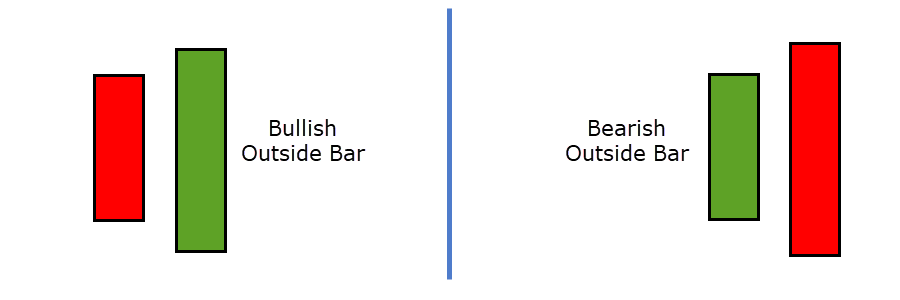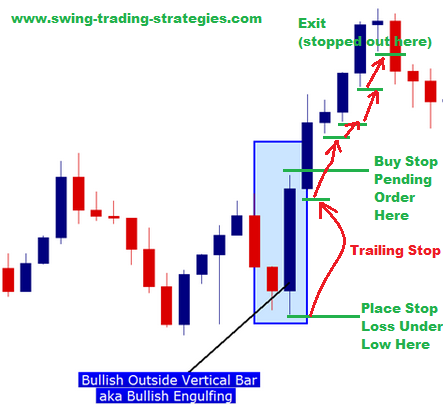Outside Bar Forex Trading Strategy is a price action candlestick pattern for the Forex market, Futures or any other market you choose to trade.
It can be both a bullish reversal pattern, a bearish reversal, or even be used during a continuation move from some type of consolidation. It’s actually similar to the inside bar Forex system except for the larger bar or candlestick being on the right side of the most recent price action. Think of the “mother bar” of an inside bar pattern being on the opposite side of price.
Where the inside bar indicates lower volatility, an outside bar indicates higher volatility and can often lead to a strong momentum run in price.
The outside bar Forex trading strategy can be used a swing trading strategy when taken around swing points on your Forex price charts.
What Exactly Is An Outside Bar?
Whether you use the term bar or candlestick, the pattern is the exact same: high and low overshadows or engulfs the candlestick before it.
The outside bar can be either bullish or bearish and how you trade them will depend on your trading strategy. If you trend trade, you will probably only trade the outside bar pattern that conforms to your directional bias in the market.
Other terms you may have heard for an outside bar are:
- Bullish Engulfing pattern
- Bearish Engulfing pattern
 Not shown in this graphic are the upper and lower shadows however as long as the outside bar completely covers the bar beside it in any form, it will no doubt trade the same.
Not shown in this graphic are the upper and lower shadows however as long as the outside bar completely covers the bar beside it in any form, it will no doubt trade the same.
This chart pattern will be easily visible on a chart and they can appear virtually any place on the chart. This does not mean you will simply trade them as they appear.
You want to add some variables to any trading strategy that utilizes an outside bar.
Trading Outside Bars
Trading the outside bars is straight forward and here are the rules of the outside bar Forex trading system:
- When an outside bar forms, for your entry, you place a buy stop order if bullish outside bar and a sell stop order if bearish outside bar 2-5 pips above the high(if bullish outside bar) and 2-5 pips below the the low (if bearish outside bar). When there is a breakout of high or low, you are triggered into the trade.
- Place stop loss in a similar manner on the other side, 2-5 pips away from the low if its a buy stop order and 2-5 pips above the high if its a sell stop order.
- Take profit has a few options: target previous swing high points (if its a buy order), or previous swing low points if its a sell order. Or 3 times your risk…if you risk 50 pips initially, then you you should set your take profit target at a price level where once hit, will give you a 150 pips profit (3 times your risk).
Trade Management
One of the best trade management technique is to use trailing stops behind the low if its a buy order and above the high if its a sell order. You will get stopped out when a candlestick knocks out the low of the previous candlestick(for a buy order) or you will get stopped out when the high of the previous candlestick is intersected for a sell order.
Note that the chart above is for a buy trade only. A sell trade setup would be the complete opposite of that.
Inside Bars Don’t Have To Be A Trading Strategy
Understanding what the inside bar means on a chart is useful information.
If the previous candlesticks are smaller in structure and you get an outside bar formation, something has changed in the market. An outside bar can actually be part of a price scan that shows markets that have the potential to start a run in price.
Once you see an inside bar, you could use any number of the trading strategies on the website to find trades.
In other words:
- A quiet market suddenly forms an outside bar
- You know that volatility may have returned to the market
- You implement another trading strategy to take advantage of the potential moves to come
Inside bars can simply be information and not an event you trade.
Watch Where Inside Bars Form
As mentioned, on any time frame, in an uptrend or down trend, you can get this chart pattern to form. What you would like to see is this formation taking place at important structures or even an indicator zone – where other traders may see what you are seeing:
- Support or resistance zones
- Extreme highs or lows
- Forming after a pullback to a moving average such as the 20 EMA or 50 period moving average
You can see that increased volatility at a specific area that has the potential to either hold price or even cause a price reversal, is a great potential trade. The key is to monitor for follow-through in price and to ensure that this increased volatility is not due to some news release.
Disadvantages To Trading With Inside Bars
- Stop loss distances can be huge (the larger the time frames used, the larger the stop loss), which means you need to calculate lot sizes based on the risk you are willing to take.
- It may take a while before you can start to see some profits on your trades. This is because the outside bar has already moved a great deal and the next 2-3 candlesticks may be digesting the move that just happened. We all see how after a run in price, it seems that price just stops moving.
- Tempting to trade wherever you find them. You should take trades on outside bar when the chart pattern happens around support or resistance levels, Fibonacci levels, pivots etc.
Why Are Inside Bars A Decent Pattern?
- Easy to Spot and the trading rules are very easy to understand and implement.
- Market has potential to move a very long way when these outside bars form and can bring you hundreds of pips if you ride out the swing or trend buy using trailing stops especially if you are a swing trader.
- You may even be catching a full trend reversal if you are catching them on daily charts and above.
Don’t forget to like, tweet or share by clicking the buttons below.





 Posted in
Posted in